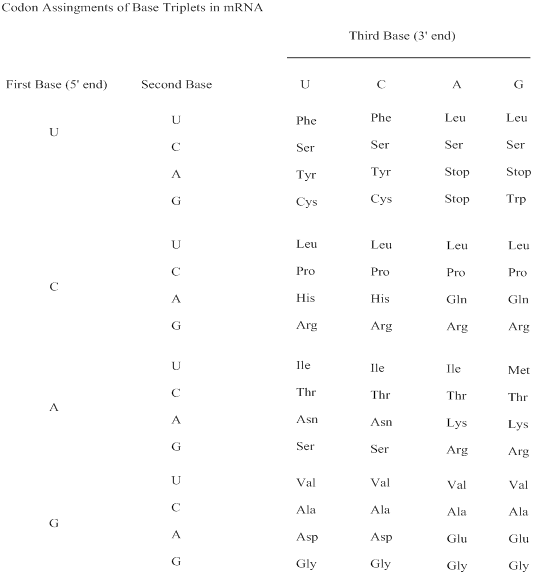
Concept explainers
Interpretation:
The possible amino acid for GAG code and other codes for the same amino acid has to be predicted.
Concept Introduction:
Codon: A sequence of three ribonucleotides in the mRNA chain that codes for a specific amino acid; also a three-
Genetic code: The sequence of nucleotides, coded in triplets (codons) in mRNA that determines the sequence of amino acids in protein synthesis.

Illustrated relationships are:
DNA informational strand: 5’ ATG CCA GTA GGC CAC TTG TCA 3’
DNA Template strand: 3’ TAC GGT CAT CCG GTG AAC AGT 5’
mRNA: 5’ AUG CCA GUA GGC CAC UUG UCA 3’
protein: Met Pro Val Gly His Leu Ser
Notice: 5’ end of the mRNA strand codes for the N-terminal amino acid, whereas the 3’ end of the mRNA strand codes for the C-terminal amino acid. Proteins are always written N-terminal to C-terminal, reading left to right.
Want to see the full answer?
Check out a sample textbook solution
Chapter 26 Solutions
Pearson eText Fundamentals of General, Organic, and Biological Chemistry -- Instant Access (Pearson+)
- 5) Theoretically, ATP did not have to become our bodies' main energy currency. Two alternative carriers, acetyl phosphate and S-adenosylmethionine could have been utilized, rather than ATP. AG" for acetyl phosphate hydrolysis is -43.3 kJ/mol and AG" for S- adenosylmethionine hydrolysis is -25.6 kJ/mol. (a) Calculate the weight of each alternative energy carrier that would need to be consumed by humans on a 2000 calorie per day diet if our bodies could not recycle it. Assume a 50% absorption of energy from our diet. (b) If our bodies contain 25g of each alternative energy carrier and they CAN be recycled, how many times would each molecule of each energy carrier need to be recycled? (c) Comment on the special properties of ATP and why it is unlikely that these alternative carriers would be utilized biologically.arrow_forwardGive three reasons why evolution may have selected for phosphates compared to othersimilar leaving groups such as conjugated carboxylic acids or amides. Explain whatbenefit each of your reasons has granted to the living organism.arrow_forwardThe preferred substrate is T because the enzyme half-saturates at 7.00 mM for T, but requires 28.0 mM for U, and 112 mM for S. b Question Content Area The rate constant k 2 with substrate S is 9.60×107 sec-1, with substrate T, k 2 = 6.00×104 sec-1, and with substrate U, k 2 = 2.40×106 sec-1. Calculate the catalytic efficiency with S, T, and U. Catalytic efficiency with S = Catalytic efficiency with T = Catalytic efficiency with U = Does enzyme A use substrate S, substrate T, or substrate U with greater catalytic efficiency?arrow_forward
- Fumerase catalyzes the conversion of fumerate to malate. fumerate + H2O ⇋ malate The turnover number, kcat, for fumerase is 8.00×102 sec-1. The Km of this enzyme for fumerate is 5.00×10-3 μmol mL-1. a In an experiment using 2.00×10-3 μmol·mL-1, what is Vmax?arrow_forwardSuppose you wanted to make a buffer of exactly pH 7.00 using KH2PO4 and Na2HPO4. If the final solution was 0.18 M in KH2PO4, you would need 0.25 M Na2HPO4. Now assume you wish to make a buffer at the same pH, using the same substances, but want the total phosphate molarity ([HPO42−]+[H2PO−4]) to equal 0.20 M. What concentration of the Na2HPO4 would be required?arrow_forwardMatch the three types of neurotransmitters to their relative size (largest to smallest): Largest Peptide neurotransmitter ✓ Second largest [Choose] Smallest > [Choose ] [Choose ] Amino acid neurotransmitter Peptide neurotransmitter Amine neurotransmitterarrow_forward
- need help not sure why its wrong please helparrow_forwardWhy the 2nd choice is correct?arrow_forwarda) What are the differences between the Direct & Indirect Immunofluorescence Assays? (0.5 mark) b) What are the advantages of the Indirect Immunofluorescence Assays? (0.5 mark) c) A Super-Resolution Imaging Technique was developed in 2018 using imidazole, a His-tag ligand conjugated with a fluorophore to report the presence of a recombinant His-tag protein target, (Sci Rep, 2018, 8:5507). How does this technique improve the image quality? (2 marks)arrow_forward
- a) What are the differences between the Direct & Indirect Immunofluorescence Assays? b) What are the advantages of the Indirect Immunofluorescence Assays? c) A Super-Resolution Imaging Technique was developed in 2018 using imidazole, a His-tag ligand conjugated with a fluorophore to report the presence of a recombinant His-tag protein target, (Sci Rep, 2018, 8:5507). How does this technique improve the image quality?arrow_forwardCalculate the number of ATP produced from oxidation of 1 molecule of glucosearrow_forwardExample 1: 1. Suppose an enzyme (MW = 5,000 g/mole) has a concentration of 0.05 mg/L. If the kcat is 1 x 10 s, what is the theoretical maximum reaction velocity for the enzyme? A) 1050 µM/s. B) 100 µM/s. C) 150 μM/s. D) 105 μM/s.arrow_forward
 Human Heredity: Principles and Issues (MindTap Co...BiologyISBN:9781305251052Author:Michael CummingsPublisher:Cengage Learning
Human Heredity: Principles and Issues (MindTap Co...BiologyISBN:9781305251052Author:Michael CummingsPublisher:Cengage Learning Biology Today and Tomorrow without Physiology (Mi...BiologyISBN:9781305117396Author:Cecie Starr, Christine Evers, Lisa StarrPublisher:Cengage Learning
Biology Today and Tomorrow without Physiology (Mi...BiologyISBN:9781305117396Author:Cecie Starr, Christine Evers, Lisa StarrPublisher:Cengage Learning Biology (MindTap Course List)BiologyISBN:9781337392938Author:Eldra Solomon, Charles Martin, Diana W. Martin, Linda R. BergPublisher:Cengage Learning
Biology (MindTap Course List)BiologyISBN:9781337392938Author:Eldra Solomon, Charles Martin, Diana W. Martin, Linda R. BergPublisher:Cengage Learning BiochemistryBiochemistryISBN:9781305577206Author:Reginald H. Garrett, Charles M. GrishamPublisher:Cengage Learning
BiochemistryBiochemistryISBN:9781305577206Author:Reginald H. Garrett, Charles M. GrishamPublisher:Cengage Learning Human Biology (MindTap Course List)BiologyISBN:9781305112100Author:Cecie Starr, Beverly McMillanPublisher:Cengage Learning
Human Biology (MindTap Course List)BiologyISBN:9781305112100Author:Cecie Starr, Beverly McMillanPublisher:Cengage Learning





